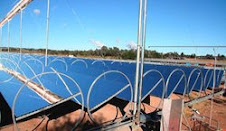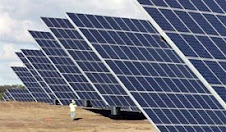Spain: New Plan for Renewable Energy
by Jose Gil and Hugo Lucas
Madrid, Spain
Spain's new energy law, passed earlier this summer, is designed to attract 23 billion Euro [approx. USD$27 billion] in investment by improving the legislative environment for renewable energy.
The challenge is to make the renewable energy sector attractive to private investors, and to maintain and strengthen the interest that has been consolidated in some sectors, and extend it to others in which only timid steps have been taken so far.
-- Plan de Energias Renovables The Energy Context in Spain
One of the characteristics of the Spanish energy system is its high degree of dependence on imports. 80 percent of energy consumption has to be met from imported sources. Spain imports approximately 64 percent of the coal, 99.5 percent of the oil and 99.1 percent of the gas it uses. Moreover, oil accounts for around 50 percent of primary energy consumption.
The strategies defined for the energy sector have been shaped by the international commitments of the European Union as a whole, and those of Spain in particular relating to energy supply and climate change. Promoting the use of energy from renewable sources plays a fundamental role in meeting both commitments.
Clearly, as is necessarily the case, Spain's energy policy objectives coincide with those established by the European Union: a competitive and transparent liberalised market, security of supply, improved energy efficiency and protection of the environment.
In Spain the development of renewable energy sources has been supported by various instruments over the last twenty-five years. A law promoting their use was first passed in 1980.
On August 26, 2005 the Spanish government approved the new Renewable Energy Plan (Plan de Energias Renovables, PER), which supersedes the Renewable Energy Promotion Plan, which dates back to 1999. The overall aim of the new Plan is to make it possible to achieve the target of 12 percent of primary energy being met from renewable sources by 2010 and to do so it sets more ambitious objectives in those areas that have been developing successfully and establishes new measures to support technologies that have not yet managed to take off.
The Renewable Energy Plan for 2005-2010 (PER)
Renewable energy sources contribute to reducing energy dependence and increasing security of supply. Moreover, the development of renewable energy can make an active contribution to job creation, generally in less favored and sparsely populated areas. They can therefore contribute to rural development and stemming the rural exodus.
The PER is an indicative Plan, meaning that it is not binding upon the actors in the energy system. However, it is hoped that slightly more than 97 percent of investments will come from the private sector. The aim is therefore to create a sufficiently attractive framework based on stability and profitability. The contribution of public funds to these investments is estimated to be just 2.9 percent.
The Institute for Diversification and Saving of Energy (Instituto para la Diversificacion y Ahorro de la Energia, IDAE), a public state-owned body, has been entrusted with the task of preparing the PER. The methodology applied during the preparation of the Plan was aimed to ensure the participation of national government, the governments of Spain's autonomous regions, and academic and professional institutions.
In each area an exhaustive analysis was conducted of state of the art technologies together with an evaluation of the requirements to overcome the main barriers to developing renewable energy sources in Spain. Concrete proposals for actions to overcome these barriers were then put forward. IDAE is also the body in charge of the monitoring of the PER.
Forecasts in the PER
In the most likely energy scenario the 2005-2010 Renewable Energy Plan targets will enable 12.1 percent of primary energy consumption to be met from renewable sources by 2010. Within this overall target, in 2010 electricity generation from renewable sources will account for 30.3 percent of gross consumption and liquid biofuels will account for 5.8 percent of petrol and diesel consumption for transport purposes.
The table below gives detailed information on the current situation and the targets for 2010.
Spain Renewable Energy Plan and TargetsTechnology Targets
As the table shows, a large share of the target is based on the contribution of wind power, which is forecast to reach 20,155 MW of installed capacity in 2010. The starting point is an installed capacity of 8,155 MW at the end of 2004.
This figure has already placed Spain in second position worldwide, just behind Germany, and ahead of the United States. The development of wind power in Spain has been accompanied by the creation of companies that have developed their own technology and who compete successfully on international markets.
By contrast, biomass, which is the other fundamental pillar to achieving the PER's targets, has not developed as fast as expected. The current Plan envisages new mechanisms to overcome the barriers to its development and, as a new feature, it includes the setting up of a co-combustion programme (for the joint combustion of biomass and coal in existing power stations).
Regarding liquids biofuels for transport (LBT) the results achieved so far make it possible to be optimistic about achieving the objectives set for 2010. In the case of bioethanol Spain is the first producer in Europe.
In solar energy, within a short space of time Spain has achieved a position of international leadership in photovoltaics, with three companies in the European top ten. By contrast, one of the challenges in the Plan is to overcome the barriers to the development of solar-thermal energy. Another important innovation envisaged in the Plan is the development of the first 500 MW solar-thermoelectric power stations in 2010.
Alongside these energy targets it is hoped that other social and environmental goals will be achieved. In terms of employment over 1,300 companies are currently registered as being active in the sector. And in terms of the environment, the application of the Plan will avoid 27.3 million tons of CO2 emissions in 2010.
Funding of the Plan
Achieving the goals set implies a volume of investment estimated at approximately 23.6 billion Euros [approx. USD$27.7 billion]. Of this 97.1 percent is expected to come from private sources. Just 681 million Euros [approx. USD$799 million], 2.9 percent of the total, will be in the form of public investment aid.
The challenge is therefore to make the renewable energy sector attractive to private investors, or rather, to maintain and strengthen the interest that has already been consolidated in some sectors, and extend it to others in which only timid steps have been taken so far.
Of the approximately 22.9 billion Euros [approx. USD$26.9 billion] that it is hoped the private sector will attract, it is estimated that 4.7 billion Euros [approx. USD$5.5 billion] will come from direct contributions from developers and the remaining 18.2 billion Euros [approx. USD$21.4 billion], will come from bank loans provided through the usual financial mechanisms.
In addition to the direct investment subsidies already mentioned, there are two other modes of public aid that are fundamental from the economic point of view. These are the premiums paid for electricity generated from renewable sources and the tax exemptions for LBT.
The premiums for electricity generated from renewable sources are fundamental. This system has been used successfully to date and has created the favorable conditions for the spectacular growth of certain sectors, in particular wind power. The premium is a supplement to the price electricity producers can obtain on the market.
The total value of the premiums related to the new generating facilities brought into operation over the period 2005-2010 is predicted to reach 4.9 billion Euros [approx. USD$5.8 billion]. From 2010 the annual premiums are forecast to be worth 1.8 billion Euros [approx. USD$2.1 billion]. It is worth stressing that although the figures are large in absolute terms, the impact on electricity prices of the premium policy is an increase of around 0.6 percent a year.
The tax incentives for the use of LBT consist of an exemption from the tax on hydrocarbon fuels of the retail price. With this measure, the price of biofuels to the final consumer can be brought down to a level that allows them to compete with petroleum derivatives.
About the Authors:
Jose Gil and Hugo Lucas are in the International Relations Department of
The Institute for Diversification and Saving of Energy (Instituto para la Diversificacion y Ahorro de la Energia, or IDAE), a public state-owned body based in Madrid, Spain.
Spain is one of eight donor countries (excluding the European Union) to Renewable Energy and Energy Efficiency Program (REEEP). Austria, Germany, Italy, Ireland, the Netherlands, Spain, the United Kingdom, the United States and the European Union all contribute funds to the REEEP.
Solar Energy links plus related sun-powered products:
find solar-powered radio-flashlight online, photovoltaic panel on radio, perfect gift, solar gadgets for sale online
buy solar electronics gadget, solar energy holiday gift, purchase sun-powered seasonal present
Kodak EasyShare One 4MP Camera with Email Centurion Solar-powered Security Light
Centurion Solar-powered Security Light
Search and buy photovoltaic products at the Alternative Energy Store, find free educational information on renewable energy systems for your home, farm or business; great prices on solar panel kits and home wind turbines.Solar-powered products for sale at Amazon.com
buy solar-powered electronics online, find solar gadgets, purchase solar calculator, buy photovoltaic electronics, solar energy powered electronics for sale online
Photovoltaic solar energy panels, order online 
buy holiday gifts online, seasonal shopping, purchase present for teenager, search for best gift
Solar Photovoltaic Books at Amazon.com ICP Solar 21000 SolarPRO Plug'n'Play 100-Watt Kit
ICP Solar 21000 SolarPRO Plug'n'Play 100-Watt Kit
End of Renewable Energy Links List







